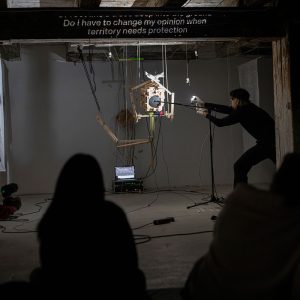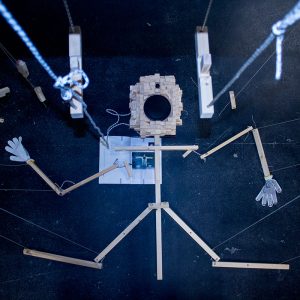
Ari-Pekka Leinonen: ADONNER
performance and installation
45 minute runtime + 15 minute afterglow
ADONNER (French: a donner = to give), performance explores through rap music and speculative “sound staging choreography” the phenomenon of giving. A fixed soundtrack dismisses the sound performer and allows the investigation of the roles of a choreographer, a puppeteer, a stagehand, a light designer and many other out of spotlight roles that invisibly give their support to the performer and to the performance. By becoming a “jack-of-all-trades-technician” or a “one-man team”, the performer tries to create a flow of activities that animate the soundtrack and one loudspeaker-headed-puppet. The performance utilises a 9-channel ele-gi-eli sound sculpture plus a new 2-way sculptural loudspeaker. After the performance the stage design, the sound sculptures, the soundtrack and the video documentation will constitute an installation that resurrects and replays the live performance.
ADONNER narrates a story about hearing the last will of Apillione Bustaman, a fictional character, who was looking for another fictional character called ADONNER. During the search Bustaman ends up giving and receiving in several different places, eventually having not much more to give away than the memories of the search. Bustaman takes a bath, eats food, ventures in business, does research, breaks the law, is punished, is sentenced to No-land, escapes from self-denial and drifts to Yo-land, transforms into a bird and saves Funland, flies to the space and sees horror on the earth, is homeless, turns into vampire, is healed by the DJ Fizzy, is shown a good example of asking questions, finds ADONNER and gives the testament and dies.
ADONNER is a prodigal son of a circular economy practised in Brussels. Its music is based on over hundred free 7” records salvaged from the streets, which were later digitised and sampled. The choreography and the rap music is inspired by the natural powers and flow of the Danube river and it draws inspiration from numerous Finnish and international rap music influences. The story is shapeshifted by the city of Budapest and the events that circulate around it. The format of the performance is imaginarily inspired by the unseen puppet-show by Polish director Zygmunt Smandzik, and tries speculatively to give voice to his wordless 45-minute puppet show “Ptak” (bird) premiered in 1975 in Opole, Poland. The puppet-show was discovered from a random book on the bookshelf at Art Quarter Budapest. ADONNER tries to approach the circular economy by borrowing, stealing and relentlessly receiving from already existing.
“Ptak: It was a poem without words, full of lyricism, philosophical suggestions and hints. ….. Ptak shows an ever ending process of creating leaders-idols and gods, and their destruction, the creation and collapse of ideas in which man believed as bringing a promise of a better and fair life, but which were destroyed due to egoisms, and rotten and corrupted governments.” People and Puppets Tales About Theatre (2008) Zbigniew Bitka, p. 22
“… Ptak lasts forty five minutes like a school lesson. It is a lesson of imagination (given by the stage designer) and of thorough, team work (by performers).” People and Puppets Tales About Theatre (2008) Zbigniew Bitka, p. 79
ADONNER was initiated with a support from Arts Promotion Center Finland and was concluded in a 3-month artist in residency at Art Quarter Budapest supported by FinnAgora as part of the pARTir initiative funded by the European Union – Next Generation EU.



